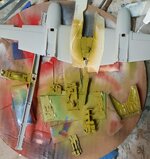User name: Davecww1
First name: Dave
Category: Advanced
Manufacturer: Tamiya
Model: Lockheed P-38 F/G Lightning
Scale: 1/48
Add ons: Quinta cockpit detail, Ultracast seat, 3d printed wheels from Tomasz Gronczewski, and perhaps the Eduard Brassin gun bay set.
I 'm looking to do aircraft flown by Capt Tom Lynch. I have a sheet from Superscale for his -H but it needs a few corrections or additions.
Dave
First name: Dave
Category: Advanced
Manufacturer: Tamiya
Model: Lockheed P-38 F/G Lightning
Scale: 1/48
Add ons: Quinta cockpit detail, Ultracast seat, 3d printed wheels from Tomasz Gronczewski, and perhaps the Eduard Brassin gun bay set.
I 'm looking to do aircraft flown by Capt Tom Lynch. I have a sheet from Superscale for his -H but it needs a few corrections or additions.
Dave
Attachments
Last edited:











